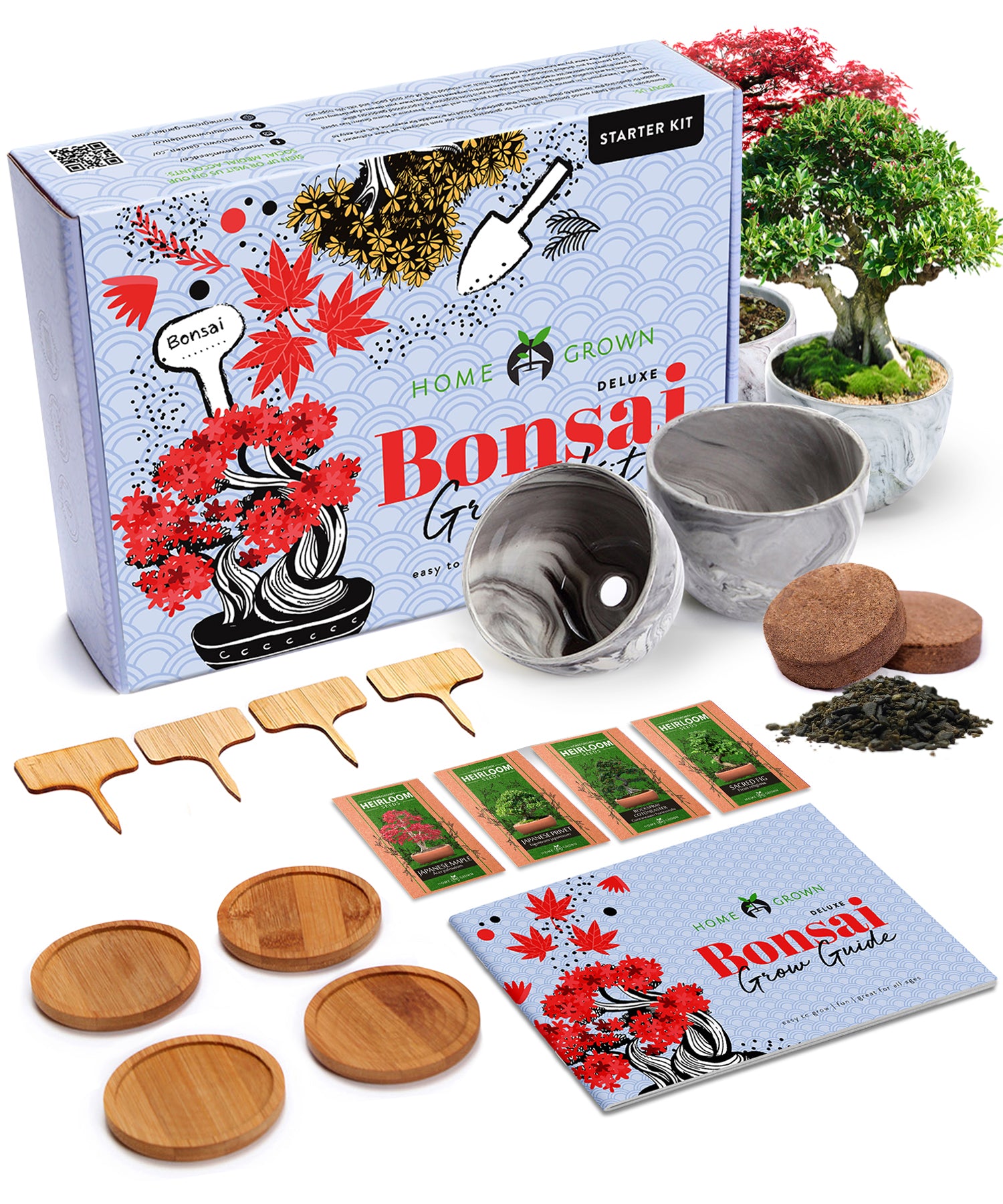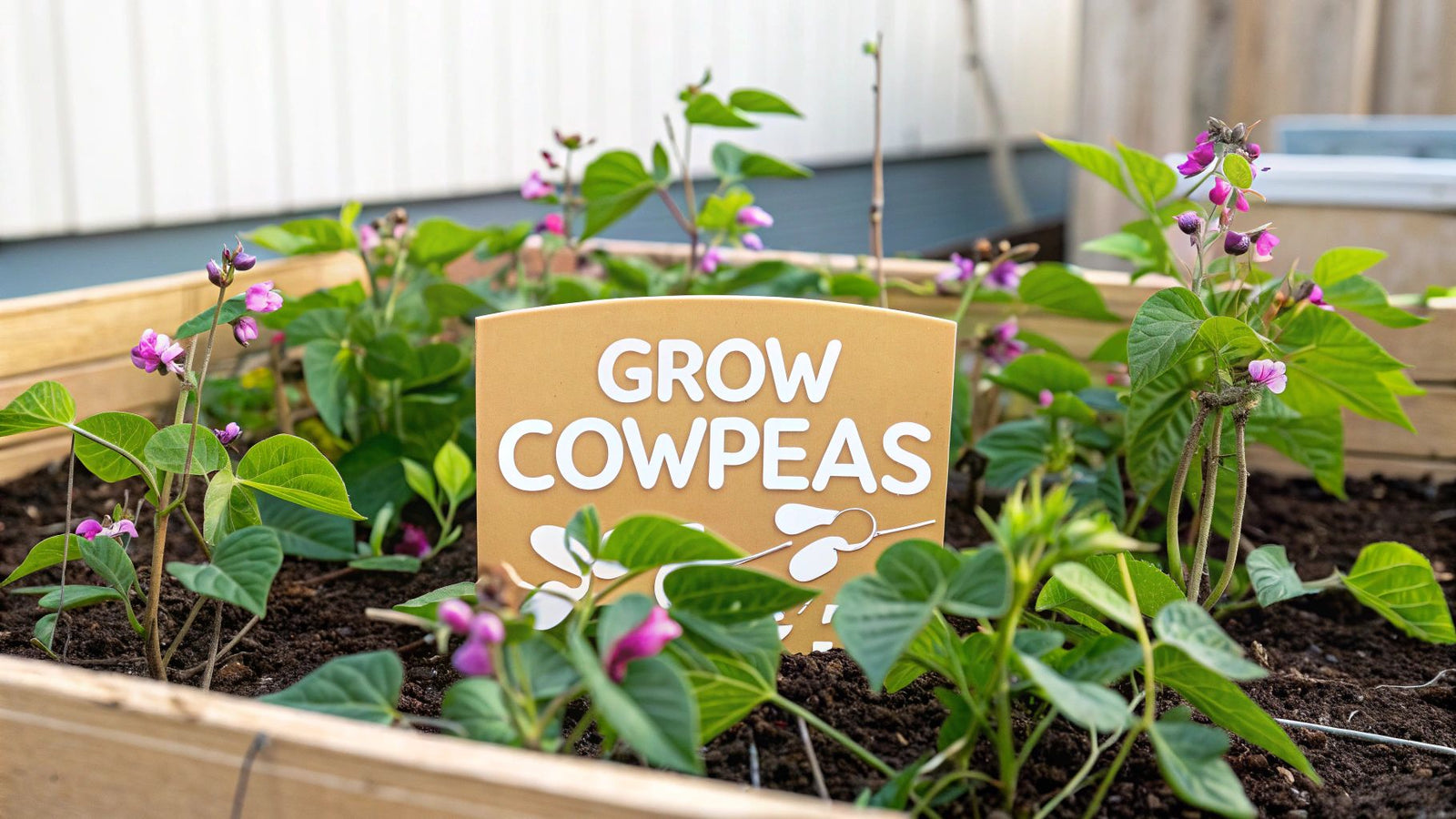
If you've ever spent a summer in the South, you know about Pinkeye Purple Hull cowpeas. They're a garden staple for a reason—easy to grow, tough as nails in the heat, and absolutely delicious. This particular variety of Southern pea is famous for its rich, earthy flavor and the sheer volume of peas you can get from just a few rows.
Their name tells you exactly what to look for: a vibrant purple hull and a little pink "eye" on the pea itself when it's time to start shelling.
3 Reasons Why Gardeners Love Pinkeye Purple Hull Cowpeas
Let's walk through everything you need to know to get a fantastic harvest of Pinkeye Purple Hull cowpeas. They're one of my personal favorites because they're not just a reliable food source; they actually make your garden better while they grow.
These aren't sprawling vine monsters. Pinkeye Purple Hull is a semi-bushy variety, staying a manageable 45 to 60 centimeters tall. The pods, which are about 15 to 20 centimeters long, tend to cluster right at the top of the plant, making them incredibly easy to spot and pick.
Each pod is packed with 9 to 11 small, kidney-shaped beans. You'll know they're ready when the pod shifts from green to that signature purple and the peas inside show off their magenta eye. They're also an excellent cover crop and a treat for local wildlife. If you're curious, you can discover more about the versatility of these plants.
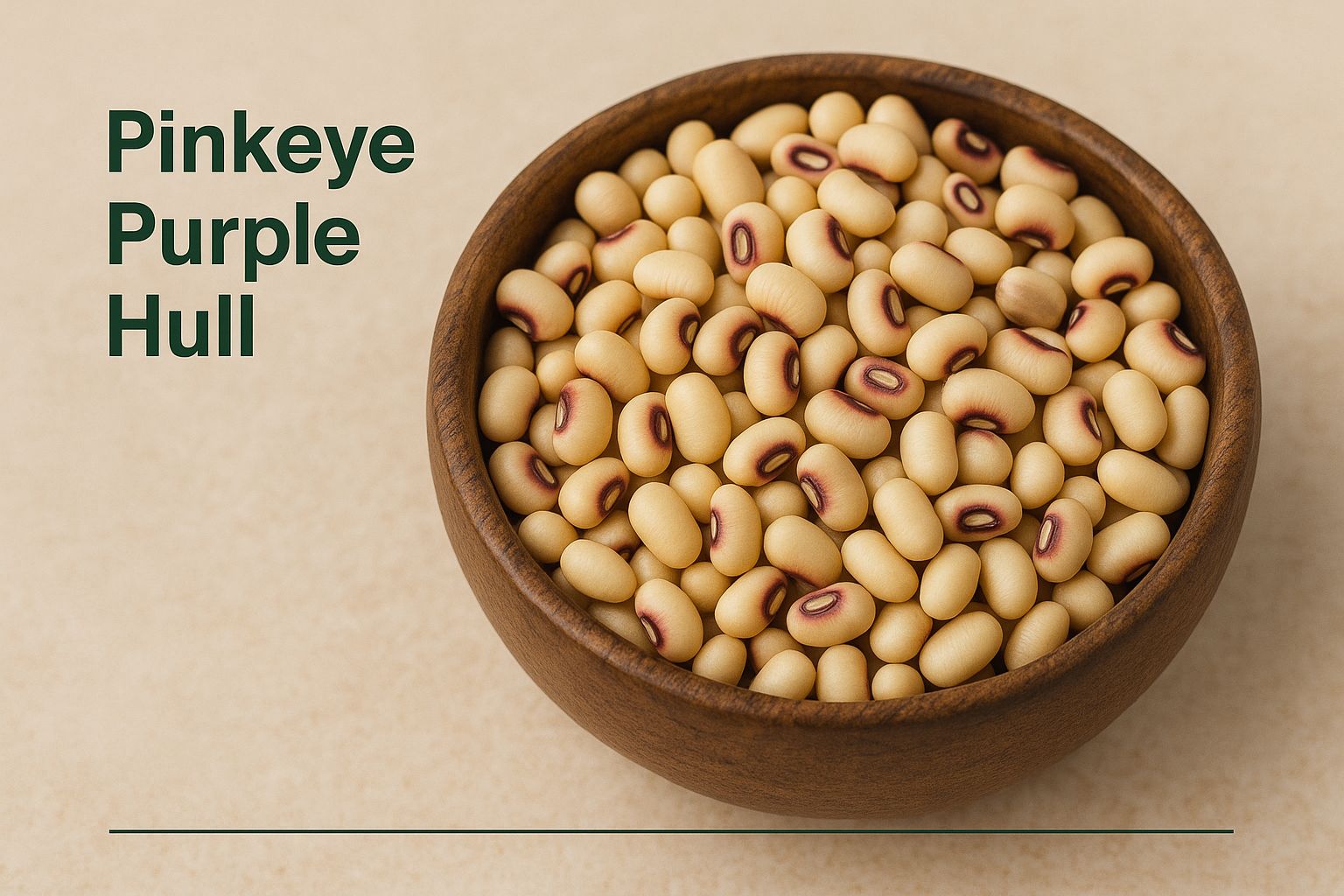
This image gives you a perfect look at what you're aiming for: fresh, creamy-colored peas with that unmistakable pink eye.
So, why do so many seasoned gardeners swear by this specific cowpea? It comes down to a few key traits that make them a rewarding and practical choice for almost any garden.
- 1. Loves the Heat: When your other garden vegetables are wilting under the intense summer sun, these cowpeas are just getting started. Their exceptional heat tolerance makes them one of the most dependable crops for mid-summer.
- 2. Builds Your Soil: Like all legumes, these plants are nitrogen-fixers. They literally pull nitrogen out of the air and store it in their roots, leaving your soil richer and more fertile for whatever you plant next. It's like a fertilizer and a food crop all in one.
- 3. Incredibly Productive: Don't let their compact size fool you. A small patch of Pinkeye Purple Hulls can yield a massive harvest. You’ll often get several pickings from the same plants throughout the season, keeping your kitchen stocked.
If there's one thing to remember, it's this: Pinkeye Purple Hull cowpeas give back more than they take. They're a low-maintenance, high-yield plant that actively improves your garden's soil health, setting you up for even better results next year.
To give you a better idea of what to expect, here's a quick look at the major milestones you'll see from planting to harvest.
Pinkeye Purple Hull Cowpea Growth Timeline
This table breaks down the key stages and what you should be doing at each point.
| Growth Stage | Timeline After Planting | Key Actions |
|---|---|---|
| Germination | 4-10 days | Ensure soil is consistently moist but not waterlogged. Watch for first sprouts. |
| Vegetative Growth | 2-4 weeks | Plants establish roots and leafy growth. Thin seedlings to proper spacing. |
| Flowering | 35-50 days | Small, delicate flowers appear. Ensure consistent watering. |
| Pod Development | 50-60 days | Pods form and begin to fill out. Monitor for pests like aphids. |
| Harvest | 60-75 days | Pods turn purple and feel full. Begin picking for fresh peas or let them dry on the vine. |
Following this timeline will help you anticipate the needs of your plants and ensure you're ready to enjoy a fantastic harvest right on schedule.
4 Essential Steps to Prepare Your Garden for Cowpeas
A bountiful harvest of pinkeye purple hull cowpeas doesn't just happen by tossing some seeds in the dirt. The real magic begins long before that—it's all in the prep work. While these plants are pretty tough, giving them the right start makes the difference between a decent yield and a truly impressive one. Your main goal is to create a garden spot that feels like home: warm, sunny, and well-drained.
1. Find a Sun-Soaked Location
First things first, let's talk about location. Your cowpeas are sun worshippers, plain and simple. They need a spot that gets a solid six to eight hours of direct sunlight every day. This is a non-negotiable for them. Anything less, and you'll see lanky plants and disappointing pod production. If you have a south-facing plot, that's usually the prime real estate.
2. Ensure Excellent Drainage
Once you've scouted the perfect sunny patch, it's time to get your hands dirty and focus on the soil. Pinkeye purple hull cowpeas have one major pet peeve: "wet feet." Their roots will quickly rot if they're left sitting in soggy, waterlogged ground. For this reason, excellent drainage is absolutely essential.
Not sure about your drainage? Here's a quick and easy test. Dig a hole about a foot deep, fill it with water, and see how long it takes to disappear. If it's gone within a few hours, you're golden. If that water is still sitting there the next day, you've got some work to do.
3. Amend Your Soil Properly
Here’s how I get a bed ready for cowpeas:
- Loosen Things Up: First, I break up the top 8 to 10 inches of soil. Whether you use a tiller or a sturdy garden fork, the goal is to eliminate compaction. This gives the roots plenty of room to stretch out and search for water and nutrients.
- Bring in the Good Stuff: Next, I work in a healthy amount of organic matter. A few inches of finished compost or some well-aged manure is perfect. This stuff is a miracle worker—it helps heavy clay soil drain better while also giving sandy soil a bit more substance to hold onto moisture.
- Smooth it Out: After mixing everything in, I grab a rake and level the surface. A smooth, even bed means your seeds will be planted at a consistent depth, which really helps with uniform germination.
4. Skip the Heavy Fertilizer
A piece of hard-won advice: hold back on the fertilizer. Cowpeas are legumes, which means they are fantastic "nitrogen-fixers." They literally pull nitrogen from the air and store it in their roots. If you add a high-nitrogen fertilizer, you'll get a beautiful, lush jungle of leaves but very few pea pods.
One of the most common mistakes I see gardeners make is killing their cowpeas with kindness. They overdo it by creating a soil bed that's far too rich. These plants honestly prefer moderately fertile soil. So, fight the urge to reach for that bag of all-purpose fertilizer. A simple addition of compost at the beginning of the season provides all the nutrition your plants need to get going.
7 Pro Tips for Planting Your Cowpea Seeds
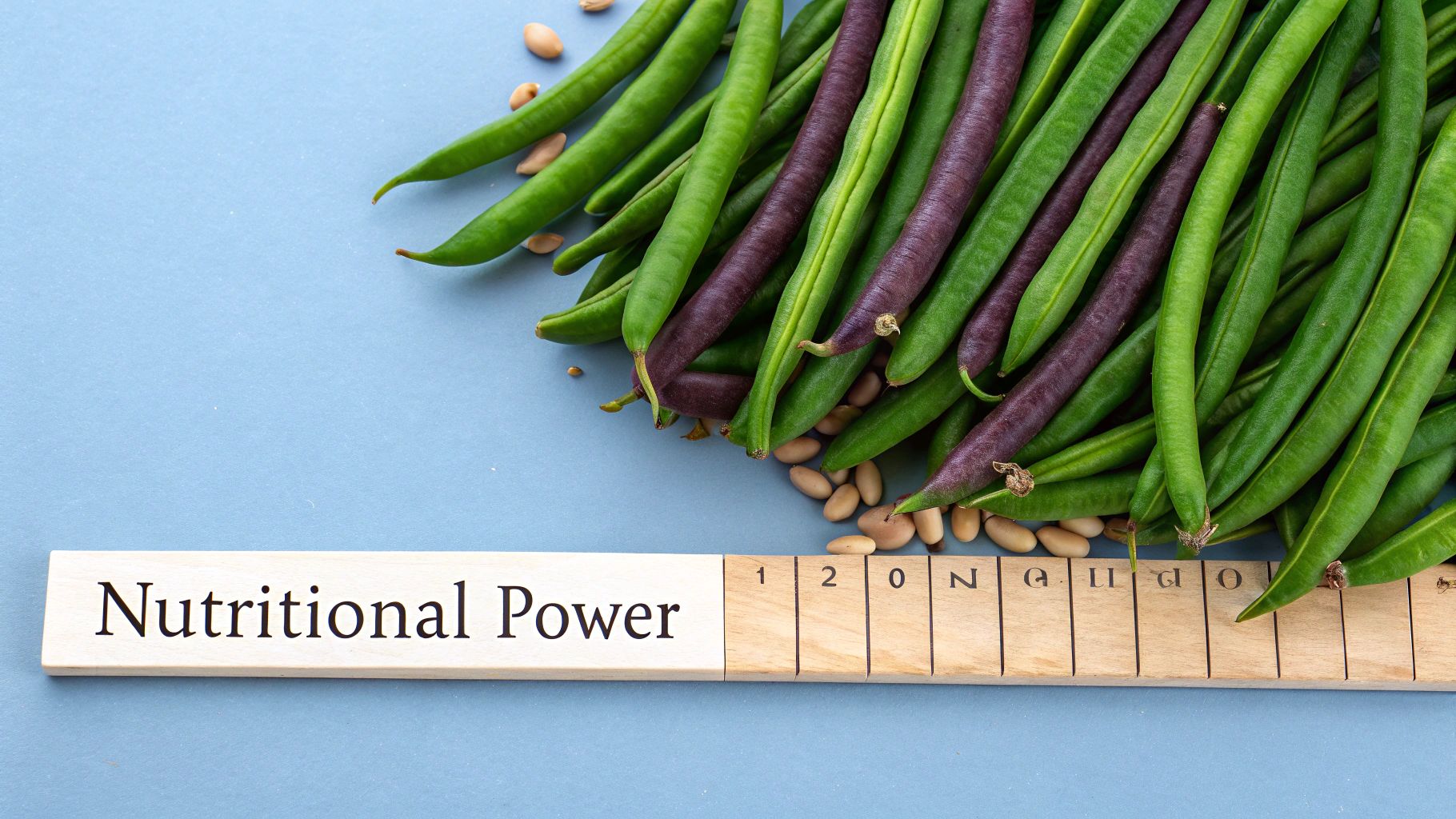
With your garden bed prepped and ready, it's time for the fun part—getting those pinkeye purple hull cowpea seeds planted. This isn't just about digging a hole; getting the timing and technique right from the start is what sets you up for a fantastic harvest later on.
One of the most common mistakes I see is planting by the calendar instead of by the weather. Cowpeas are true warm-weather lovers and they absolutely will not sprout in cold, damp soil. Plant them too early, and you're just inviting poor germination or, even worse, your seeds might rot before they even get a chance. The key is to wait until the soil itself has warmed up to at least 65°F (18°C), about two weeks after your last frost.
Planting these seeds is pretty simple, but a few small details can make a huge difference in your success. Follow these tips, and you'll give your cowpeas the best possible start.
-
1. Get the Depth Just Right: Aim for a consistent planting depth of about one inch. Any shallower and the seeds might dry out or get nabbed by birds. Go too deep, and the tiny seedlings will struggle to push their way up to the sunlight.
-
2. Space Seeds Properly: Place your seeds about four inches apart within the row. This gives each plant plenty of personal space to develop strong roots without having to fight its neighbors for food and water.
-
3. Give Your Rows Room to Breathe: I like to space my rows anywhere from 24 to 36 inches apart. This not only gives me room to walk through for weeding and harvesting but also ensures good air circulation, which is your best friend in preventing common fungal diseases.
-
4. Give Them a Boost with Inoculant: Before you plant, I highly recommend treating your seeds with a pea and bean inoculant. It’s a simple, inexpensive powder that contains beneficial bacteria called Rhizobium. These little helpers work with the plant to pull nitrogen from the air, which can seriously boost your yields.
-
5. Water with a Gentle Hand: Once the seeds are in, give the bed a gentle but thorough watering. The goal is to settle the soil around the seeds, not blast them out of place. Keep the soil consistently moist (think damp sponge, not a mud puddle) until you see seedlings pop up, which usually takes about 4 to 10 days.
-
6. Thin for a Stronger Stand: After your seedlings are a few inches tall, you’ll need to make a tough choice. Thin them out so the strongest plants are about six inches apart. It can feel counterintuitive to pull out healthy seedlings, but this step is critical. It ensures the remaining plants have all the resources they need to grow big and productive.
-
7. Sow Seeds Directly in the Garden: Unlike tomatoes or peppers, cowpeas just don't like being moved. They have a sensitive central taproot that gets easily damaged, so they should always be sown directly into the garden. If you want to learn more about which plants do benefit from an early start, check out our guide on when to start seeds indoors.
5 Easy Ways to Keep Your Cowpea Patch Thriving
Once you see those first green sprouts pushing through the dirt, your job shifts from planter to caretaker. The great news is that pinkeye purple hull cowpeas are famously low-maintenance. They won't demand your constant attention, but a few smart habits will ensure your plants are healthy, productive, and set you up for a fantastic harvest.
Keeping your cowpea patch in good shape is pretty straightforward. By focusing on these five key areas, you can head off most common problems before they even get started.
1. A Smart Watering Strategy
Pinkeye purple hull cowpeas are drought-tolerant, but don't mistake them for cacti. They'll produce the best pods when they get consistent moisture, especially once they start flowering and setting pods. A good rule of thumb is to give them about one inch of water per week, whether from your hose or from rainfall. The trick is to water deeply and infrequently, rather than giving them a light sprinkle every day.
2. Keeping the Weeds at Bay
Weeds are more than just an eyesore—they're thieves, stealing water, sunlight, and nutrients from your cowpeas. Once your plants are a few inches tall, spread a two- to three-inch layer of straw, shredded leaves, or grass clippings around their base.
A thick layer of mulch is a gardener's best friend. It smothers out most weeds and helps the soil hold onto precious moisture. That means less time weeding and watering for you. It's a simple step with a huge payoff.
3. Go Easy on the Fertilizer
Whatever you do, resist the urge to feed your cowpeas with a high-nitrogen fertilizer. As legumes, they are masters at making their own nitrogen right in the soil. Adding more will just give you a jungle of leafy growth with very few pea pods. If you mixed some good compost into your soil at planting time, no additional fertilizer is needed.
4. Handling Pests the Organic Way
The two main pests you might run into are aphids and the cowpea curculio. A strong blast of water from the hose can often knock off aphids, or you can use insecticidal soap. For the cowpea curculio, the best defense here is good old-fashioned crop rotation. Don't plant cowpeas in the same spot year after year. For a deeper dive, check out our guide on how to plant and care for a vegetable garden.
5. Give Them Some Air
Good airflow is your secret weapon against fungal diseases like powdery mildew. When you plant, make sure you space your rows 24 to 36 inches apart. This simple step ensures air can move freely between the plants, helping the leaves dry off quickly after rain or morning dew and keeping those fungal issues from ever getting started.
3 Perfect Times to Harvest Your Pinkeye Purple Hull Cowpeas
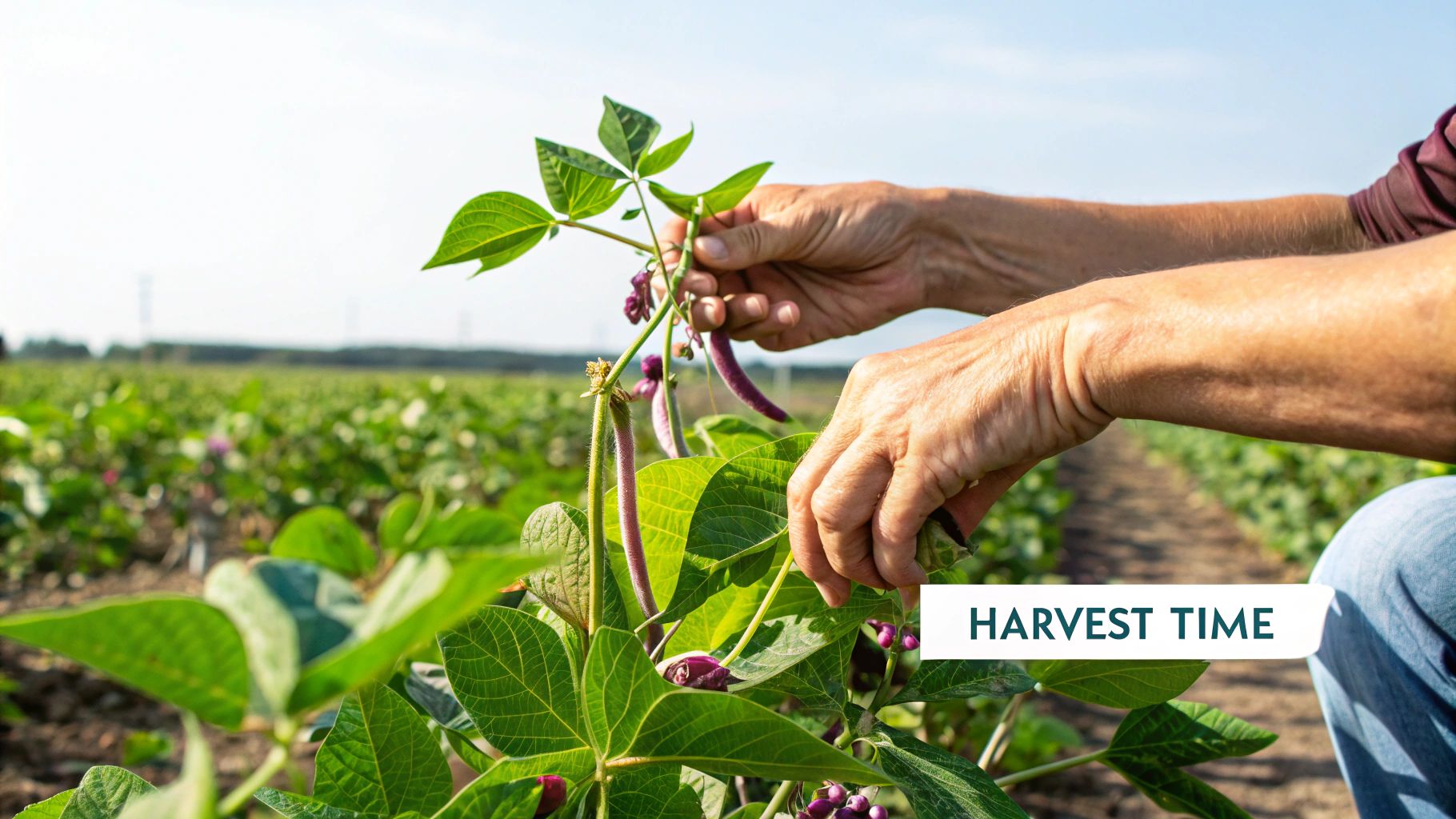
When it comes to pinkeye purple hull cowpeas, timing your harvest is everything. Pick them a bit too soon, and you'll miss out on that classic flavor. Wait just a little too long, and their texture changes completely.
The beauty of these plants is their versatility. A single row can give you three totally different types of peas. Let's break down exactly what to look for at each stage.
1. For Young, Tender Snaps
Your very first harvest will be for "snaps." This is when you pick the pods while they’re still young, slender, and bright green—well before that signature purple blush even thinks about appearing. You're looking for pods that feel firm yet flexible and snap cleanly. This stage usually rolls around about 50 days after planting.
2. For Classic Fresh Shelling Peas
This is what most gardeners are after. You’ll know it’s time when the pods have taken on that unmistakable deep, vibrant purple hue. The pod itself should feel full and lumpy, and you should be able to feel the distinct, plump peas nestled inside. This is when they've hit their peak, with that creamy texture and rich, earthy flavor.
3. For Dried Peas to Store
If you want to stock your pantry, you can let the peas dry right on the vine. Just leave those beautiful purple pods on the plant. They’ll eventually turn brown, dry out, and become brittle. When you can hear the peas rattling around inside, they’re ready.
Try to pick your dried pods on a sunny, dry afternoon. This helps ensure there’s no lingering moisture that could lead to mold during storage. Once shelled, keep the dried peas in an airtight container in a cool, dark spot, and they'll last for a year or more.
It's amazing how popular these peas are. The U.S. is a major consumer, but we actually rely quite a bit on imports to keep up with demand. In a recent year, the import value for dried cowpeas hit a staggering $282.09 million USD. It just goes to show the broad appeal of varieties like the pinkeye purple hull. You can dig into more stats about the global cowpea market and U.S. demand at Tridge.com.
3 Common Questions About Growing Cowpeas Answered
Growing pinkeye purple hull cowpeas is usually a pretty smooth ride, but questions always pop up. This is your go-to guide for figuring out those common head-scratchers.
1. Why Are My Cowpea Plants Turning Yellow?
It’s always a little jarring to see your healthy green plants start to turn yellow, but don't panic. More often than not, the cause is something simple, and usually, it's a case of overwatering. Cowpeas absolutely hate having "wet feet." Their roots can't breathe in soggy soil, which can lead to root rot and yellow leaves.
Here's a quick checklist to run through:
- Check the Soil: Stick a finger about an inch deep. If it feels wet, back off on the watering for a few days.
- Think About Drainage: Make sure water isn't pooling around the base of your plants after a rain. Good drainage is non-negotiable.
- Look for Bugs: Check the undersides of the leaves for any tiny uninvited guests like aphids.
2. Do Pinkeye Purple Hull Cowpeas Need a Trellis?
This is a great question, and the answer is one you'll love: almost certainly not. The Pinkeye Purple Hull is a bush-type or semi-vining variety. It grows into a nice, compact plant, usually topping out at around 18 to 24 inches tall.
One of the best things about this variety is its neat and tidy growth. All the pods form in clusters right at the top, so you don't have to go hunting through a jungle of vines to find them. It makes harvesting a breeze.
This self-supporting habit means you can skip the hassle and expense of setting up trellises. For more solid advice on getting your garden off the ground, check out our resource on building a vegetable garden for beginners.
3. How Many Times Can I Harvest From One Plant?
Get your harvesting basket ready, because you're in for a long and productive season! Pinkeye purple hull cowpeas are an indeterminate variety, which is exactly what a gardener wants to hear. It means they'll keep on flowering and making new pods as long as the weather stays warm. The real secret to a huge yield is to harvest regularly. The more you pick, the more the plant produces. You can absolutely count on getting multiple harvests from every single plant.
At Homegrown Garden, we believe everyone can grow their own food. We provide the high-quality heirloom seeds and expert guidance you need to succeed, whether you have a large yard or a small balcony. Start your gardening journey with us today at https://www.homegrown-garden.com.

